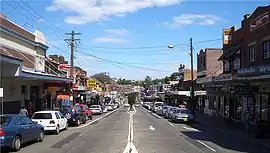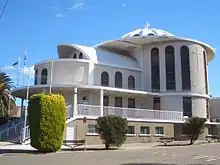Belmore, New South Wales
Belmore is a suburb of Sydney, in the state of New South Wales, Australia. Belmore is located 11 kilometres south-west of the Sydney central business district, in the local government area of the City of Canterbury-Bankstown.
| Belmore Sydney, New South Wales | |||||||||||||||
|---|---|---|---|---|---|---|---|---|---|---|---|---|---|---|---|
 Burwood Road, Belmore | |||||||||||||||
| Population | 12,718 (2016 census)[1] | ||||||||||||||
| Postcode(s) | 2192 | ||||||||||||||
| Location | 11 km (7 mi) inner south-west of Sydney CBD | ||||||||||||||
| LGA(s) | City of Canterbury-Bankstown | ||||||||||||||
| State electorate(s) | Canterbury | ||||||||||||||
| Federal Division(s) | |||||||||||||||
| |||||||||||||||
| 🌍 |
History
Belmore is named after the fourth Earl of Belmore, Governor of New South Wales from 1868-1872. The area was known as Darkwater in its early days. Some of the first land grants in 1810 were 40.5 hectares (100 acres) to Richard Robinson east of Sharp Street and Kingsgrove Road and 24 hectares (60 acres) to Thomas Mansfield, to the west. Francis Wild and John Sullivan were each granted 12 hectares (30 acres) in 1823. The area was originally used for market gardens and orchards. Subdivision started after the railway came through in 1895.[2]
The first school, Belmore South Primary School opened on 25 April 1892 and the post office opened in 1907. The town centre began developing in the 1920s and features some classic examples of art-deco architecture.
Today Belmore is considered the Art Deco of the Canterburty Bankstown LGA.
Heritage listings
Belmore has a number of heritage-listed sites, including:
- Burwood Road: Belmore railway station[3]
- 32-36 Redman Parade: Community facilities
- 481 Burwood Road: Doctor's surgery
- 543 Burwood Road: Electricity Substation No. 274
- 5 Knox Street: Electricity Substation No. 276
- 35 Isabel Street: Federation and Inter War House
- 37-37A Isabel Street: Federation and Inter War House
- 39 Isabel Street: Federation and Inter War House
- 2 Wilson Avenue: Federation Bakery, White House Bakery
- 436 Burwood Road: Federation detached house Station Master's house
- 37 Wilson Avenue: Federation House
- 52 Albert Street: Federation House
- 43 Wilson Avenue: Federation Weatherboard House
- 370-372 Burwood Road: Inter War Building Post Office (former)
- 35, 37 & 39 Isabel Street: Federation and Inter War House
- 2, 4, 6, 8, 10, 12, 14, 16, 18 Lakemba Street: Californian Bungalows Inter War House
- 103-105 Lakemba Street: Built in the 1920s
- 12 Oxford Street: Victorian House
- 31 Forsyth Street: Victorian Villa The Towers
Houses
Belmore has a high percentage of period homes. It's predominately a low-rise residential area full of well-maintained period family homes with large back-yards, wide tree-lined streets, and small parks and playgrounds. Art Deco shop façades dominate the small shopping strip. There are now an increasing number of high-rise units in the suburb mostly along Canterbury Road.
Pubs and Clubs
Canterbury Leagues Club
Located on 26 Bridge Rd, is an entertainment venue. The clubdates back to 1957 to service the needs of the football club and local community. The Club also amalgamated with Lakemba Services Memorial Club (2001) and the Moxon Sports Club.
St George Hotel
Located on 618 Canterbury Rd, is a heritage-listed landmark.
Commercial area
Belmore contains a mixture of residential, significant landmarks, commercial and industrial developments. The main commercial area is located along Burwood Road, near Belmore railway station. Commercial and industrial developments are also located along Canterbury Road and surrounding streets.
Transport
Belmore railway station is located on the Bankstown Line of the Sydney Trains network. The line was opened in 1895 and electrified in 1926. The station at Belmore opened on 1 February 1895. Belmore has many bus routes navigating to the south, to the north and the inner south west to the Sydney CBD.
Churches
- All Saints Greek Orthodox Church
- St Alban's Anglican Church
- St Joseph's Catholic Church
- Belmore Church of Christ.
Schools
Belmore South Public School
The Heritage Listed Belmore South Public School was officially opened on the 22 January 1917.
Belmore Boys High School
Belmore Boys' High is a small, comprehensive, multicultural high school.
St Joseph's Primary School
St Joseph’s Primary School is a coeducational K-6 primary school.
All Saints Grammar
All Saints Grammar School is a co-educational Orthodox Christian School from Pre-Kindergarten to Year 12, run under the auspices of the Greek Orthodox Archdiocese of Australia.[4]
Gallery
 All Saints Greek Orthodox Church
All Saints Greek Orthodox Church St Joseph's Catholic Church
St Joseph's Catholic Church Belmore Boys High School
Belmore Boys High School The Towers, a heritage-listed house in Forsyth Street[5]
The Towers, a heritage-listed house in Forsyth Street[5]
Sport
Belmore Sports Ground is the home ground of the National Rugby League team Canterbury-Bankstown Bulldogs. It is the current home ground for New South Wales Premier League team Sydney Olympic. The "Back to Belmore" campaign was established in August 2005 to upgrade Belmore Sports Grounds as a top-class sporting facility to NRL standards for the Bulldogs to stage a select number of NRL games at their traditional home ground in the long-term future.
 Belmore Hotel
Belmore Hotel Belmore Brewery, St George Hotel
Belmore Brewery, St George Hotel Canterbury Leagues Club
Canterbury Leagues Club
Social Media
The online community of Belmore, have adopted to keep in touch with each other using the Facebook app. The Facebook Group is called Belmore 2192. Currently there are over 450 followers.
Population
Demographics
According to the 2016 census of Population, there were 12,718 residents in Belmore. 43.7% of residents were born in Australia, compared with the national average of 66.7%. The next most common countries of birth were Greece 6.3%, China 5.3%, Lebanon 4.1%, Vietnam 3.5% and South Korea 2.9%. 27.7% of people only spoke English at home. Other languages spoken at home included Greek 14.1%, Arabic 12.8%, Mandarin 4.6%, Vietnamese 4.4% and Korean 3.6%. The most common responses for religious affiliation were Catholic 24.1%, Eastern Orthodox 17.8%, No Religion 14.3% and Islam 12.9%.[1]
References
- Australian Bureau of Statistics (27 June 2017). "Belmore (State Suburb)". 2016 Census QuickStats. Retrieved 16 March 2018.

- Pollen, Frances (1990). The Book of Sydney Suburbs. Australia: Angus & Robertson Publishers. p. 26. ISBN 0-207-14495-8.
- "Belmore Railway Station Group". New South Wales State Heritage Register. Office of Environment and Heritage. H01081. Retrieved 18 May 2018.
- All Saints Grammar
- State Heritage Register
External links
| Wikimedia Commons has media related to Belmore, New South Wales. |
- Lesley Muir and Brian Madden (2009). "Belmore". Dictionary of Sydney. Retrieved 25 September 2015. [CC-By-SA]
- All Saints Grammar
- Back to Belmore - Back to the Future, Back to Basics


